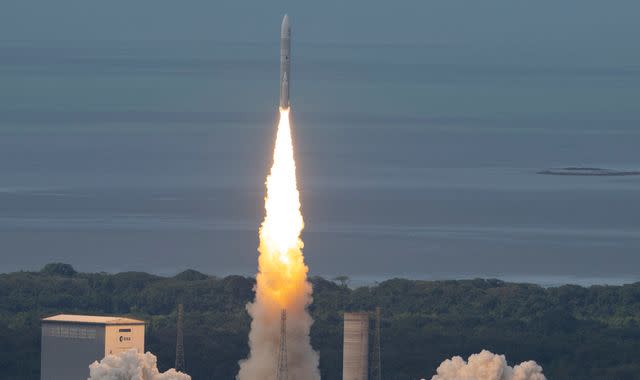Europe's newest rocket Ariane 6 blasts off in 'historic' maiden voyage

Europe's newest rocket Ariane 6 has launched from French Guiana on the northern coast of South America.
If the full launch is a success, it will give the European Space Agency (ESA) the ability to launch satellites again by itself.
Ariane 6 took off from Europe's Spaceport in French Guiana, just after 8pm BST after having a four-hour launch window from 7pm to 11pm.
Its inaugural flight is expected to take just under three hours.
Just before 9pm BST ESA director general Josef Aschbacher posted on X to say the rocket was in circular orbit.
A short while later, he posted a video of celebrations from headquarters, with the caption: "We have made history for Europe."
"Everything is nominal, everything is going so well and this is such a beautiful moment," he said.
Once in operation, Ariane 6 will become the space agency's newest taxi to low orbit, able to carry satellites and equipment up out of the atmosphere.
It is the latest in a long line of Ariane satellite launchers, with the most recent, Ariane 5, taking the James Webb Space Telescope and the Jupiter Icy Moons Explorer into space.
Ariane 5 was retired last year and since then the European Space Agency has had to rely on the commercial sector to launch its satellites.
Making an impact on European history
"Standing next to the massive Ariane 6 is indescribable," Mr Aschbacher posted on X, before the launch.
"I feel a wide range of emotions as we get ready to make an impact on European history, for Europe's future, for generations of Europeans."
The rocket is carrying several new satellites and experiments into orbit, including a smart-farming satellite, a radio beacon demonstrator and even capsules destined to re-enter Earth's atmosphere to test new materials.
Its upper stage can reignite multiple times during flight, meaning it can take a wide range of spacecraft into orbit and then save a final boost to return and burn up in Earth's atmosphere.
Read more from Sky News:
Nearby exoplanet stinks of rotten eggs, scientists discover
Arsenic, lead and other toxic metals found in tampons
Ariane 6 is 63 metres tall but it's less powerful than other NASA, SpaceX and Chinese rockets.
Its big benefit, however, is its simplicity.
Ariane 6 is designed to be cheaper and easier to build - it cost an estimated €4bn (£3.4bn) - which should give the ESA the ability to launch once a month if needed.


